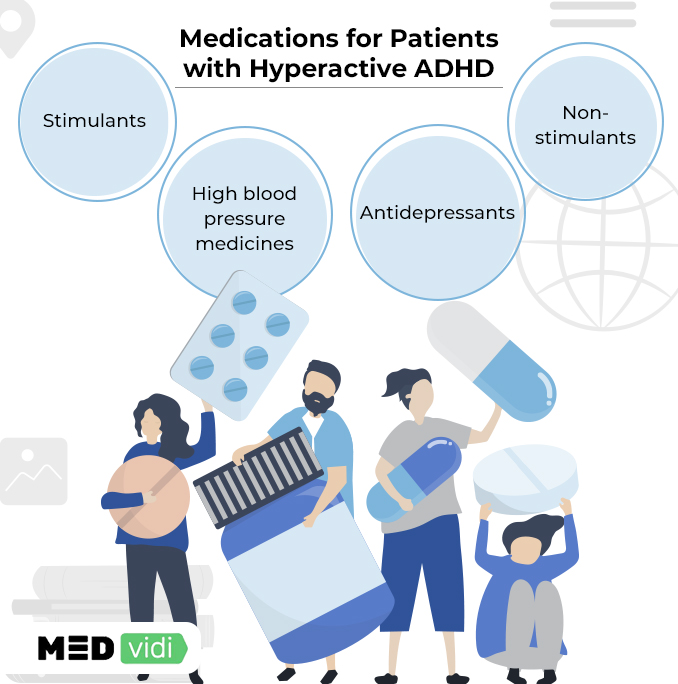Highlights
- Attention deficit hyperactivity disorder (ADHD) has three subtypes: predominantly inattentive, predominantly hyperactive-impulsive, and combined.
- Predominantly hyperactive-impulsive ADHD is generally the rarest subtype in adults.
- Hyperactive-impulsive symptoms are usually more subtle in adults than in children with ADHD.
When you think of ADHD in adults, you most likely think of attention deficit symptoms: someone who has difficulty paying attention and struggles to focus; their desk may be a mess, they’re forgetful, always late, or rarely meet deadlines.
On the other hand, the younger children with ADHD you’ve come across often appear hyperactive. Running around screaming, climbing on furniture, and writing on walls, they appear naughty and out of control.
It might surprise you that adult ADHD hyperactivity symptoms exist; they just present differently.
Let’s explore the symptoms, diagnosis, and management of hyperactive-impulsive ADHD in detail.
What Is Hyperactive-Impulsive ADHD?
Worldwide, attention deficit hyperactivity disorder (ADHD) is a commonly diagnosed mental health condition. As the name suggests, there are two broad symptom groups: low attention and high energy (hyperactivity). But there are also symptoms indicating low impulse control (impulsivity).
In fact, in ADHD, hyperactivity and impulsivity go hand in hand. In 2013, ADHD diagnosis was no longer a ‘one description fits all’ condition, and three subtypes of ADHD were recognized:
- Predominantly inattentive subtype
- Predominantly hyperactive-impulsive subtype
- Combined (combination of the above)
Hyperactive-impulsive ADHD (ADHD-HI) is diagnosed when people with ADHD have high energy and low impulse control, which causes more life disruption than low attention.

Next, let’s look at why people develop ADHD; the reasons are the same for inattentive and hyperactive-impulsive ADHD subtypes.
Causes and Risk Factors of Hyperactive-Impulsive ADHD
ADHD is one of the neurodevelopmental conditions, and usually starts in early childhood. These conditions happen when a trigger affects brain development and function, impacting learning, communication, behavior, and motor skills. Other examples include autism spectrum disorder (ASD) and specific learning disorders.
So what are the triggers? They are usually genetic or non-genetic (environmental factors).
- DNA plays a
significant role[1] , ADHD is highly heritable and often runs in families. Triggers in the person’s environment[2] might impact the brain, and these can happen before or after birth. Here are a few examples:
- Alcohol, cigarette, or drug use during pregnancy.
- Low birth weight.
- Premature birth.
- Exposure to chemicals or heavy metals like pesticides, lead, or mercury.
- Longstanding issues with sleep quality.
- Traumatic brain injury.
- Stroke.
You might have heard that poor parenting, too much screen time, too few micronutrients, or too much sugar causes ADHD, but these are likely myths, as there is no clear evidence.
Next, we’ll chat about how doctors make the diagnosis.
How Hyperactive-Impulsive ADHD Is Diagnosed
Healthcare professionals use the
What they are looking for in adults is:
- At least five symptoms in the following list:
- Moving hands and feet, rocking on chairs, or swiveling on chairs, clicking or tapping pens.
- Feels uncomfortable sitting for a normal time: at the dinner table, in a restaurant, in a meeting.
- A general feeling of restlessness; difficulty relaxing.
- Is generally loud.
- Always on the go, like a motor is driving them; other people can’t keep up.
- Talks a lot.
- Interrupts conversations, completes other people’s sentences.
- Extreme frustration and difficulty waiting in queues or traffic.
- Intrudes on others: takes over tasks or uses things without permission.
- Some of the symptoms were present before age 12.
- Some symptoms are present in two or more settings, such as at home and work.
- They are affecting the quality of life and causing poor functioning.
- No other mental health condition is causing the symptoms.
The hyperactive impulsive subtype makes up about
Inattentive ADHD Subtype vs. Hyperactive-Impulsive ADHD Subtype
A person with predominantly inattentive symptoms may experience difficulty concentrating, struggle to focus, be easily distracted. They may also make careless mistakes, be forgetful, frequently lose things, and have poor time management, resulting in being late for appointments and missing deadlines.
If you’re recognizing inattentive and hyperactive-impulsive symptoms in yourself, you might have combined ADHD. Why not take this free, 5-minute screening test to analyze your symptoms in more detail?
What Hyperactive-Impulsive ADHD Feels Like
If you ask a person with hyperactive-impulsive ADHD how they feel, this is how they may respond; let’s see if you relate to any of the answers.
Non-physical symptoms that the person with ADHD is experiencing internally:
- “My mind races all the time, jumping from one thought to the next.”
- “Queues frustrate me; I’d rather leave or push in than wait my turn.”
- “It feels like there’s always something to do.”
- “I have trouble sitting for long because I feel trapped and uncomfortable.”
- “There’s a constant feeling of restlessness in my mind and body, and I struggle to relax.”
- “I feel like I’m constantly overworking, but I can’t stop.”
- “I feel like I’m losing my mind; I do unexpected things, like spending my whole salary, or drinking way too much, which I never do.”
- “I’m constantly disappointed in myself because of impulsive decisions that I regret; I have no self-control, like when I quit my job or the time I cheated on my partner.”
Physical symptoms of hyperactivity in ADHD can be seen and impact other people:
- “People think I’m rude when I take over tasks or use things without asking, but it’s because I feel like I need to get things done.”
- “I talk so fast that people miss half of what I’m saying.”
- “I can’t handle traffic and drive like I’m in a hurry, even when there’s no need. I think that’s why people don’t want to drive with me; and I’ve had accidents.”
- “I constantly fidget without even realizing it: tapping my fingers, bouncing my knee, clicking pens, rocking back and forth in chairs, picking at my skin, and pulling at my hair; it irritates those around me.”
- “I tend to be louder than others around me, even when I don’t mean to be; sometimes I’m the life of the party, and sometimes it’s inappropriate, and upsets people.”
- “I feel an urge to speak, so I interrupt people and even finish their sentences.”
- “I can’t handle incompetence, and I’ll cause a scene to prove a point; this embarrasses my family.”
- “At times, I feel like I can’t control my feelings, and I’ll just blurt something out, so people are always commenting about my mood swings.”

How Hyperactive-Impulsive ADHD Affects Daily Life
The physical or behavioral hyperactive and impulsive ADHD symptoms can be very disruptive in everyday life, affecting interpersonal relationships at work and within the family. They may also influence work quality, self-esteem, and even physical and mental health.
Colleagues, family, and friends may grow impatient with the inappropriate, loud, or high-risk behaviours described above, even though the person with ADHD has little control over the situation.
This affects the individual with ADHD-HI’s self-esteem, leading to them developing co-existing mental health conditions, such as depression, anxiety, and sometimes, both.
With the right treatment, it’s possible to avoid the significant impact of ADHD on daily life. Talk to a medical provider in 24 hours.
Hyperactive-Impulsive ADHD Treatment
The good news is that ADHD-HI is manageable with a combination of self-help strategies and a personalized treatment plan from a mental health professional. Let’s start with a few tips you can use at work and at home.
Coping Strategies and Self-Help Tips
- Use fidget toys, stress balls, or chew gum: Satisfy your need to move in less obvious ways.
- Empty your brain: When you feel your mind is overwhelmed with racing thoughts, write them all down and pick out what’s relevant.
- Reduce stress and anxiety: The stress response triggers a surge in adrenaline, which can lead to increased hyperactivity and impulsivity. So, calm yourself with deep breathing exercises and
mindfulness[7] , which involves intentionally recognizing your feelings without judgment. - Stay physically active: Not only will exercise
decrease anxiety[8] , but it will satisfy your need to move. - Sleep more: High-quality sleep helps
reduce ADHD symptoms[9] . - Ask someone to check your behavior: If you’re getting loud, annoying people, or appearing rude, they can gently pull you aside and make you aware.
- Avoid traffic and queues: Plan your appointments and visit banks or attend meetings at quieter times of the day.
Medication
Medication
Doctors use non-stimulant medication as a second-line treatment when patients can’t take stimulants because of side effects or co-existing medical conditions.

Therapy
Psychotherapy uses different approaches to help deal with sudden, regrettable decisions, restlessness, mood swings, and socially inappropriate behavior caused by predominantly hyperactive-impulsive ADHD.
Cognitive-behavioral therapy (CBT) involves changing thoughts with negative associated feelings into more positive ones. Other CBT techniques include self-control strategies.
Family and marital therapy helps adults with ADHD rebuild relationships with loved ones. The patient with ADHD can learn how their behavior is affecting others, and family members can better understand how to deal with the display of ADHD symptoms.
In Conclusion
Pure hyperactive-impulsive ADHD is rare in adults; however, it does happen, although the symptoms are more subtle than those in children. Importantly, hyperactive-impulsive symptoms are also part of the most common subtype: combined ADHD.
If you’ve recognized some of the adult presentations of hyperactive-impulsive ADHD in yourself, and would like to find out whether you have this condition, book an online ADHD appointment at MEDvidi today; take the first step to get an accurate diagnosis and a personalized treatment plan.
FAQ
What is the rarest form of ADHD?
The rarest form of ADHD is the predominantly hyperactive-impulsive type; only
What does hyperactivity look like in adults with ADHD?
Hyperactivity in adults with ADHD might present with:
- tapping or twitching hands and feet,
- rocking or swiveling on chairs,
- clicking or tapping pens,
- feeling uncomfortable sitting for a normal period,
- a general feeling of restlessness and difficulty relaxing,
- racing thoughts,
- generally being loud,
- overworking,
- always being on the go,
- being told that other people can’t keep up with them.
What does ADHD impulsivity look like in adults?
Can you have inattentive and hyperactive ADHD?
Yes, you can have inattentive and hyperactive ADHD; it is known as combined ADHD and is the
Do you have to be hyperactive to have ADHD?
No, you don’t have to be hyperactive to have ADHD;












